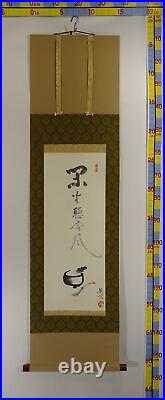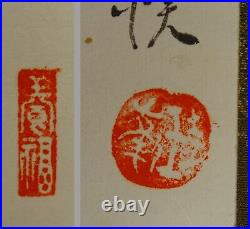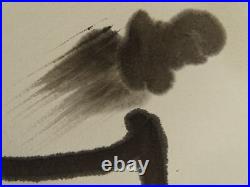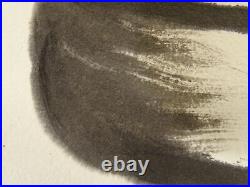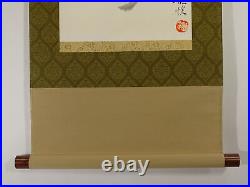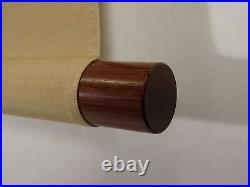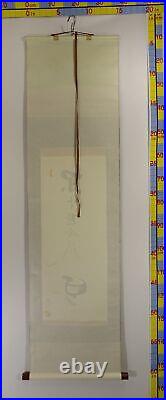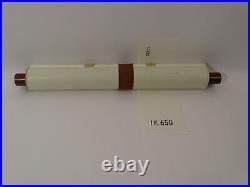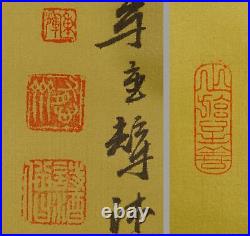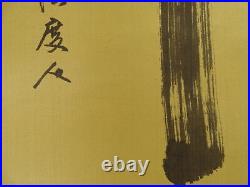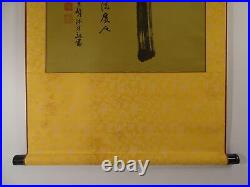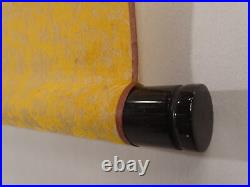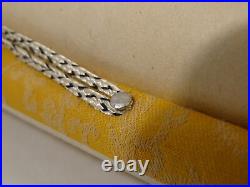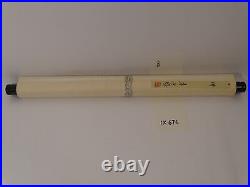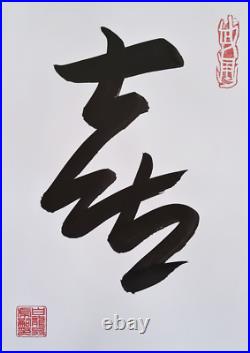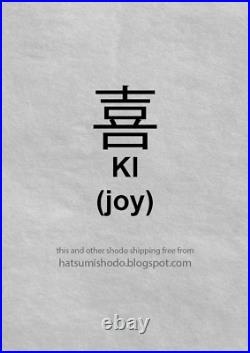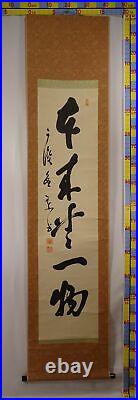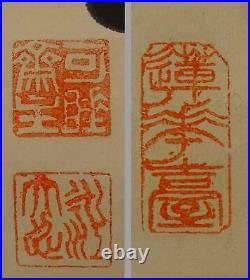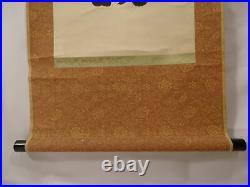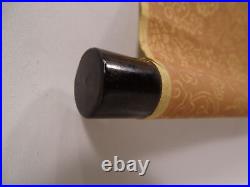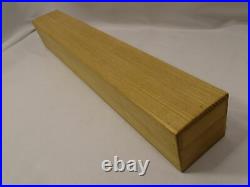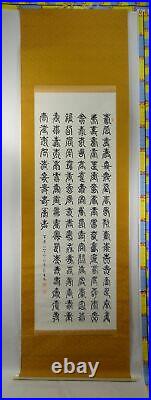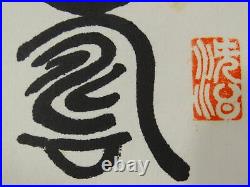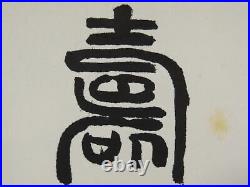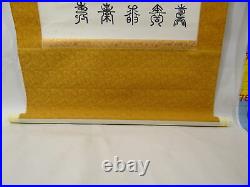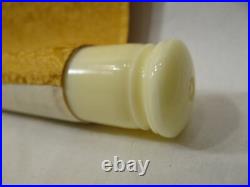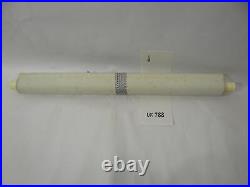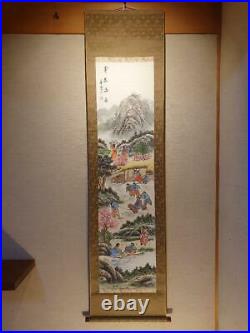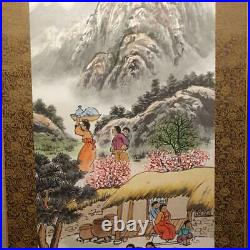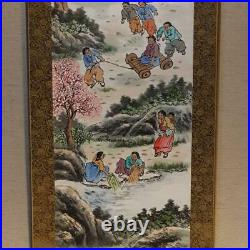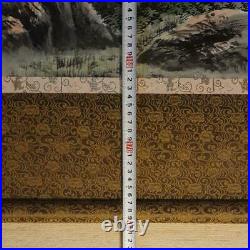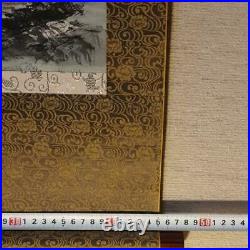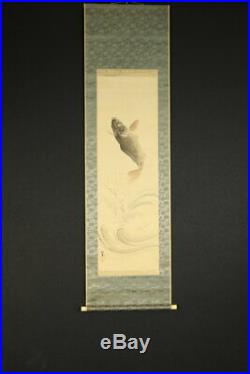





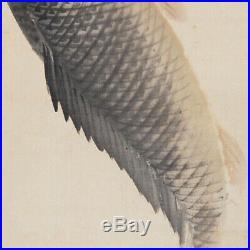
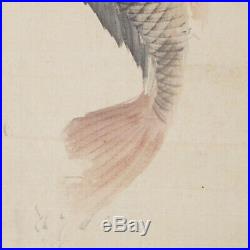

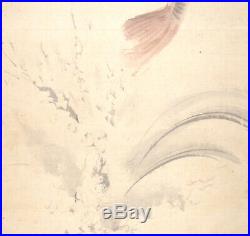

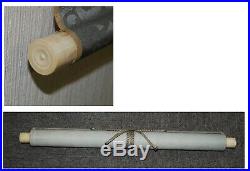

JAPANESE HANGING SCROLL KAKEJIKU / Koi Fish Painting by Shodo Yukawa #677. He was born in Wakayama pref. He studied painting techniques under Sadahiro Mitani and Shonen Suzuki. He lived in Osaka. Size: 465 mm x 1660 mm. Material of the Main Artwork: Silk. Roller End Material: Bone. What Is the Kakejiku? The kakejiku is a Japanese hanging scroll; it is a work of painting or calligraphy, which is usually mounted with silk fabric edges on flexible backings. The kakejiku can be rolled for storage. When compared to the makimono, which is meant to be unrolled laterally on a flat surface, the kakejiku is intended to be hung against a wall as part of the interior decoration of a room. It is traditionally displayed in the tokonoma alcove of a room, which is especially designed to exhibit prized objects. It can also be displayed in the most important room of the house, where a tea ceremony, or other traditional activities are performed. The kakejiku is also often hung in martial arts rooms called doujou (training rooms). Near the kakejiku, there are often other objects (okimono), such as swords (katana), dolls, bonsai, or flower arrangements (ikebana). An essential aspect of the kakejiku is that it is not intended to be hung permanently; making it versatile in its placement. This means that it can be changed at frequent intervals. One of the pleasures of the kakejiku lies in selecting a suitable one, depending on occasions, guests, and seasons. In contrast to the byoubu (folding screen), shouhekiga (wall paintings), or tsuitate (screen), the kakejiku can be easily and quickly changed to match the season or occasion. In this newly developed architectural style, the Japanese-style room (called washitsu) became a room on whose floor tatami mats are laid, and it contains one special space that is called the tokonoma alcove. The most important feature of the tokonoma is the display of kakejiku. The tokonoma was regarded as a space which connects art and daily life; so landscapes, paintings of flowers and birds, portraits, and poetry became favorite themes. They liked chanoyu (tea ceremonies) very much. Tea ceremonies were usually performed in the room with the tokonoma alcove. A tokonoma architectural style was developed and established in this period. Accompanied with the development of tokonoma style, the techniques of painting and mounting were also developed, because the kakejiku was always displayed in the tokonoma. Moreover, when Sen no Rikyuu mentioned the importance of the kakejiku, the kakejiku became extremely popular among people who were fascinated with tea ceremonies. The peacefulness of the Edo period allowed Japanese culture to reach full maturity. Many famous painters flourished and competed with each other. The kakejiku also became popular among the public. After the Meiji period (1868-), many more painters competed with each other with their techniques, because people became absolutely free to choose their own occupations during this period. Before World War 2, and for a while after that war, most Japanese-style paintings were designed to be decorated on kakejiku. Significance of the Kakejiku: Why Is the Kakejiku Changed? Why is the kakejiku (hanging scroll) replaced? The spirit of the tea ceremony, a traditional Japanese art, affects this Japanese custom deeply. There is a heart of hospitality called omotenashi in a tea ceremony. When Japanese people think about the mood of a tea ceremony, they take a lot into consideration. More specifically, they think about the various techniques they could use to make the mood the best. The kakejiku is displayed to express respect for guests indirectly, and is considered the most important tool in a tea ceremony. Therefore, the kakejiku is replaced depending on the occasions or seasons. The omotenashi heart makes them change the kakejiku. As a result, people began to think that it was important to express the formality of the occasions to guests by displaying various kinds of kakejiku. Of course, many owners have their kakejiku for the purpose of enjoying themselves, and it is also part of fun to show their lovable kakejiku to their guests. There is a tokonoma alcove in a washitsu (traditional Japanese-style room), where a kakejiku (hanging scroll) is displayed. However there is very little furniture inside the room other than the kakejiku. The Japanese people dont have a custom of hanging many paintings on the walls inside the room; they usually display a kakejiku only in the tokonoma, and replace it by another depending on the occasions, guests, and seasons. It is said that this style of display contrasts with the Western style. Many paintings are often displayed on the walls of Western buildings, such as old European buildings or palaces. For example, if there are 100 paintings, it would be the Western style to display all 100 paintings on the walls. However, the Japanese people put all 100 paintings in a closet, and choose only one to display for a short term in its fixed place (tokonoma). Therefore, there is a clear difference in functions demanded from a painting between the West and Japan. In the West, painting needs a frame for durability because it is displayed for a long time. In Japan, however, a painting does not need so much protection because it is displayed only for a short time. Handiness and convenience are very important elements for a painting, because the Japanese people will change it frequently. It is also necessary not to take up the storage space. That is to say, the style, which satisfies the above conditions, is a kakejiku-style. The kakejiku is rolled up when putting it away, and is opened while displaying it. As a result, flexibility and strength are needed to endure the process of displaying and putting it away. Therefore, the honshi (main work) is reinforced by backing it with another piece of paper, and cloths are attached around the honshi, and they are combined. This is a rough mounting process for the kakejiku. If the kakejiku is rolled up, this style prevents the honshi from creasing, tearing, and getting dirty. Even if the honshi is damaged or becomes dirty, the lifetime of the honshi and its aesthetic value can be kept for several hundred years by remounting the kakejiku. The kakejiku is an ideal style; it enables the Japanese people to enjoy their paintings at their best. We can combine some items into 1 package. (SAL / Small Packet). 2 to 3 weeks. Please feel safe that we wrap the package very well to avoid breakage in transit. The item “JAPANESE HANGING SCROLL KAKEJIKU / Koi Fish Painting by Shodo Yukawa #677″ is in sale since Wednesday, September 4, 2019. This item is in the category “Antiques\Asian Antiques\Japan\Paintings & Scrolls”. The seller is “japan_kakejiku_shop” and is located in Kobe city. This item can be shipped worldwide.
- Type: Paintings
- Featured Refinements: Japanese Hanging Scroll
- Region of Origin: Japan
- Age: 1900-1940
- Primary Material: Paper & Fabric
- Maker: Shodo Yukawa
- Original/Reproduction: Antique Original
- Color: Brown


